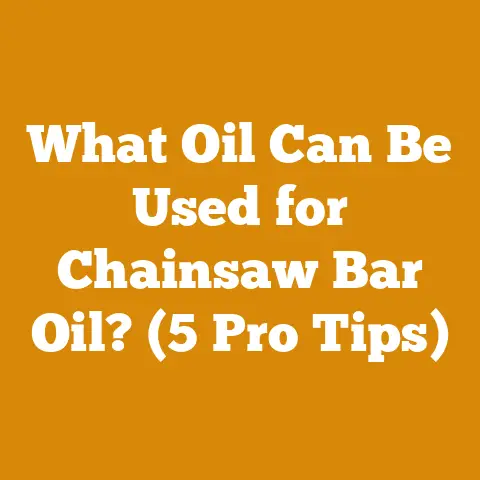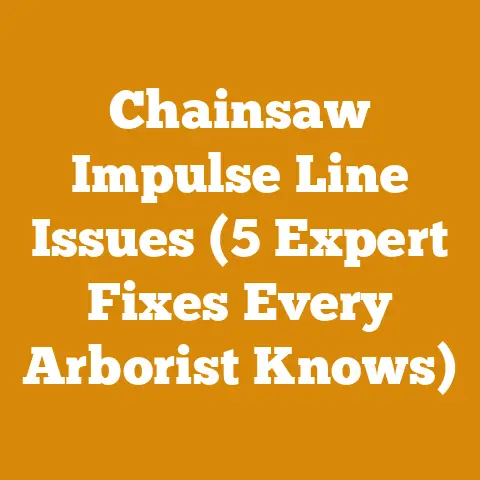Fuel Hose for Chainsaws (5 Pro Tips Every Logger Must Know)
Fuel Hose for Chainsaws (5 Pro Tips Every Logger Must Know)
As a logger who has spent countless hours in the woods, I know firsthand the frustration of a chainsaw sputtering to a halt mid-cut. More often than not, the culprit is a cracked, clogged, or otherwise compromised fuel hose. This seemingly small component is absolutely critical for keeping your saw running efficiently, and a little preventative maintenance can save you a lot of downtime and headaches. Fuel hoses are not one-size-fits-all; the specific needs vary based on regional climates, the types of wood being cut, and the frequency of chainsaw use. For instance, in colder regions, fuel hoses need to be more flexible to prevent cracking in freezing temperatures. Similarly, those of us who cut resinous woods like pine or fir need hoses that can withstand the corrosive effects of sap and pitch.
Understanding the Vital Role of Your Chainsaw Fuel Hose
The fuel hose in your chainsaw acts as the lifeline between the fuel tank and the carburetor. It’s a simple component, but its job is essential: delivering a consistent supply of fuel to keep your engine running smoothly. Without a functioning fuel hose, your chainsaw is nothing more than a heavy paperweight. The fuel hose is more than just a tube; it’s a precision component designed to withstand the rigors of chainsaw operation. This includes exposure to gasoline, temperature fluctuations, and constant vibration.
Why Fuel Hose Condition Matters
A compromised fuel hose can lead to a host of problems, including:
- Engine Stalling: Inconsistent fuel delivery can cause your chainsaw to stall frequently, interrupting your work and wasting valuable time.
- Difficulty Starting: A cracked or clogged hose can prevent fuel from reaching the carburetor, making it difficult to start the engine.
- Poor Performance: A restricted fuel supply can result in reduced power and sluggish performance, making it harder to cut through tough wood.
- Engine Damage: A severely compromised fuel hose can lead to fuel leaks, which can damage engine components and even pose a fire hazard.
Takeaway: A healthy fuel hose is essential for reliable chainsaw operation. Regular inspection and maintenance can prevent costly repairs and keep you working efficiently.
Pro Tip #1: Choosing the Right Fuel Hose
Not all fuel hoses are created equal. Selecting the right type of hose for your chainsaw and operating conditions is crucial for long-term performance and reliability. I’ve learned this lesson the hard way, after trying to save a few bucks on a generic hose that quickly deteriorated and left me stranded in the woods.
Understanding Fuel Hose Materials
Fuel hoses are typically made from one of several materials, each with its own advantages and disadvantages:
- Rubber: Rubber hoses are flexible and relatively inexpensive, but they can be prone to cracking and degradation over time, especially when exposed to gasoline and UV light.
- Tygon: Tygon is a synthetic polymer that offers excellent resistance to fuel, oil, and chemicals. It’s more durable than rubber and less likely to crack or become brittle. Tygon is my go-to choice for most chainsaw applications.
- Polyurethane: Polyurethane hoses are extremely durable and resistant to abrasion and punctures. They’re a good choice for heavy-duty applications, but they can be less flexible than rubber or Tygon.
- Viton: Viton is a high-performance synthetic rubber known for its exceptional resistance to heat, chemicals, and ozone. It’s the most expensive option, but it offers the best protection against fuel degradation and is ideal for chainsaws that are used frequently or in harsh conditions.
Matching Hose Size to Your Chainsaw
Fuel hoses come in a variety of sizes, and it’s important to choose the right diameter for your chainsaw. Using a hose that’s too small can restrict fuel flow, while a hose that’s too large can be difficult to install and may not seal properly.
- Inner Diameter (ID): The inner diameter of the hose should match the size of the fuel fittings on your chainsaw. Consult your owner’s manual or measure the existing hose to determine the correct ID. Common sizes range from 1/8 inch to 3/16 inch.
- Outer Diameter (OD): The outer diameter of the hose should be small enough to fit through the fuel tank opening and connect to the carburetor without being pinched or strained.
Considering Environmental Factors
The environment in which you operate your chainsaw can also influence your choice of fuel hose.
- Temperature: In cold climates, choose a hose that remains flexible at low temperatures to prevent cracking. Tygon and polyurethane hoses are generally more resistant to cold-weather cracking than rubber hoses.
- UV Exposure: If you frequently use your chainsaw in direct sunlight, choose a hose that is UV-resistant to prevent degradation. Viton hoses offer excellent UV protection.
- Fuel Type: If you use ethanol-blended fuels, choose a hose that is specifically designed to resist ethanol degradation. Ethanol can cause rubber hoses to swell and crack over time.
My Experience: I once made the mistake of using a standard rubber fuel hose on a chainsaw that I used primarily for cutting firewood in the summer. The hose quickly became brittle and cracked, leading to fuel leaks and engine stalling. Since then, I’ve switched to Tygon hoses for all of my chainsaws, and I haven’t had any problems since.
Takeaway: Choosing the right fuel hose is an investment in the long-term performance and reliability of your chainsaw. Consider the material, size, and environmental factors when making your selection.
Pro Tip #2: Inspecting Your Fuel Hose Regularly
Regular inspection of your fuel hose is essential for identifying potential problems before they lead to engine failure. I make it a habit to inspect my fuel hoses every time I refuel my chainsaw, and I recommend that you do the same.
Visual Inspection
A visual inspection is the easiest way to identify obvious signs of damage. Look for:
- Cracks: Cracks are a sign that the hose is drying out and becoming brittle. Even small cracks can lead to fuel leaks and engine problems.
- Bulges: Bulges indicate that the hose is weakening and may be about to burst.
- Pinches: Pinches restrict fuel flow and can cause the engine to stall.
- Abrasions: Abrasions can weaken the hose and make it more susceptible to leaks.
- Discoloration: Discoloration can indicate that the hose is being degraded by fuel or chemicals.
Flex Test
A flex test can help you identify hidden cracks and weaknesses. Gently bend the hose along its entire length and look for signs of cracking or brittleness. If the hose feels stiff or inflexible, it’s likely nearing the end of its lifespan.
Leak Test
A leak test can help you identify small leaks that may not be visible during a visual inspection. With the engine off, prime the fuel system by pressing the primer bulb several times. Then, carefully inspect the fuel hose and fittings for any signs of fuel leakage.
Checking the Fuel Filter
The fuel filter is located inside the fuel tank and is connected to the fuel hose. A clogged fuel filter can restrict fuel flow and cause the engine to stall. Inspect the fuel filter regularly and replace it if it’s dirty or damaged.
Case Study: A fellow logger I know experienced repeated chainsaw stalling. He initially suspected the carburetor but after a thorough inspection, he found a tiny, almost invisible crack in the fuel hose near the fuel filter. Replacing the hose and filter solved the problem instantly. This highlights the importance of meticulous inspection.
Takeaway: Regular inspection is key to preventing fuel hose problems. A few minutes of inspection can save you hours of downtime and costly repairs.
Pro Tip #3: Replacing Your Fuel Hose Like a Pro
When it’s time to replace your fuel hose, it’s important to do it correctly to ensure a secure and leak-free connection. I’ve seen too many loggers rush this process and end up with fuel leaks and engine problems.
Gathering Your Tools and Materials
Before you start, gather the following tools and materials:
- New Fuel Hose: Choose the correct type and size of fuel hose for your chainsaw.
- Fuel Filter: Replace the fuel filter whenever you replace the fuel hose.
- Screwdrivers: You’ll need a flathead screwdriver and possibly a Phillips head screwdriver to remove the fuel tank and carburetor covers.
- Pliers: Pliers can be helpful for removing and installing the fuel hose clamps.
- Hose Cutters or Sharp Knife: Use hose cutters or a sharp knife to cut the fuel hose to the correct length.
- Fuel Line Installation Tool (Optional): A fuel line installation tool can make it easier to thread the fuel hose through the fuel tank opening.
- Safety Glasses: Wear safety glasses to protect your eyes from fuel splashes.
- Gloves: Wear gloves to protect your hands from fuel and chemicals.
Step-by-Step Replacement Procedure
- Drain the Fuel Tank: Before you start, drain the fuel tank to prevent fuel spills. You can use a siphon or simply turn the chainsaw upside down and let the fuel drain into a container.
- Remove the Fuel Tank and Carburetor Covers: Use a screwdriver to remove the fuel tank and carburetor covers. This will give you access to the fuel hose and fuel filter.
- Disconnect the Old Fuel Hose: Use pliers to loosen the fuel hose clamps and disconnect the old fuel hose from the fuel filter and carburetor. Be careful not to damage the fuel fittings.
- Remove the Old Fuel Filter: Pull the old fuel filter out of the fuel tank.
- Install the New Fuel Filter: Attach the new fuel filter to one end of the new fuel hose.
- Thread the Fuel Hose Through the Fuel Tank Opening: Use a fuel line installation tool or carefully push the fuel hose through the fuel tank opening.
- Connect the Fuel Hose to the Carburetor: Connect the other end of the fuel hose to the carburetor. Make sure the hose is securely attached and that the fuel hose clamps are properly tightened.
- Reinstall the Fuel Tank and Carburetor Covers: Reinstall the fuel tank and carburetor covers.
- Refill the Fuel Tank: Refill the fuel tank with fresh fuel.
- Prime the Fuel System: Prime the fuel system by pressing the primer bulb several times until fuel flows through the fuel hose.
- Start the Engine: Start the engine and check for fuel leaks. If you find any leaks, tighten the fuel hose clamps or replace the fuel hose.
My Personal Tip: I always lubricate the end of the fuel hose with a little bit of fuel before attaching it to the carburetor and fuel filter. This makes it easier to slide the hose onto the fittings and helps to create a tighter seal.
Takeaway: Replacing a fuel hose is a straightforward process, but it’s important to follow the steps carefully to ensure a secure and leak-free connection.
Pro Tip #4: Maintaining Your Fuel Hose for Longevity
Proper maintenance can significantly extend the lifespan of your fuel hose and prevent costly repairs. I’ve learned that a little preventative care goes a long way in keeping my chainsaws running smoothly.
Using Fresh Fuel
Old or stale fuel can degrade the fuel hose and cause it to crack and become brittle. Always use fresh fuel that is less than 30 days old. If you’re not going to use your chainsaw for an extended period of time, drain the fuel tank and run the engine until it stalls to remove any remaining fuel from the carburetor and fuel hose.
Stabilizing Fuel
Fuel stabilizers can help to prevent fuel from degrading and can extend the lifespan of your fuel hose. Add a fuel stabilizer to your fuel whenever you’re storing your chainsaw for more than a few weeks. I personally prefer to use fuel stabilizers with ethanol protection, as ethanol can be particularly harmful to rubber fuel hoses.
Storing Your Chainsaw Properly
Proper storage can also help to extend the lifespan of your fuel hose. Store your chainsaw in a cool, dry place away from direct sunlight and extreme temperatures. Avoid storing your chainsaw in a shed or garage where it can be exposed to moisture and rodents. Rodents can chew on fuel hoses, causing leaks and engine problems.
Cleaning Your Chainsaw Regularly
Regular cleaning can help to remove dirt, debris, and fuel residue that can damage the fuel hose. After each use, wipe down your chainsaw with a clean cloth to remove any excess fuel or oil. Pay particular attention to the fuel hose and fuel fittings.
Avoiding Harsh Chemicals
Avoid using harsh chemicals or solvents to clean your chainsaw, as these can damage the fuel hose and other engine components. Use a mild soap and water solution to clean your chainsaw.
Real-World Example: I know a logger who routinely leaves his chainsaw sitting in the back of his truck, exposed to the elements. As a result, his fuel hoses degrade much faster than mine, and he has to replace them more frequently. By storing my chainsaws properly, I’m able to extend the lifespan of my fuel hoses and save money on repairs.
Takeaway: Proper maintenance is key to extending the lifespan of your fuel hose and preventing costly repairs. Use fresh fuel, stabilize your fuel, store your chainsaw properly, and clean it regularly.
Pro Tip #5: Troubleshooting Common Fuel Hose Problems
Even with proper maintenance, fuel hose problems can still occur. Knowing how to troubleshoot common issues can help you diagnose and fix the problem quickly and get back to work.
Engine Stalling
If your engine is stalling frequently, the fuel hose may be cracked, clogged, or pinched. Inspect the fuel hose for any signs of damage and replace it if necessary. Also, check the fuel filter to make sure it’s not clogged.
Difficulty Starting
If your engine is difficult to start, the fuel hose may be preventing fuel from reaching the carburetor. Prime the fuel system by pressing the primer bulb several times. If fuel doesn’t flow through the fuel hose, the hose may be blocked or the fuel filter may be clogged.
Poor Performance
If your engine is running poorly, the fuel hose may be restricting fuel flow. Inspect the fuel hose for any pinches or kinks. Also, check the fuel filter to make sure it’s not clogged.
Fuel Leaks
Fuel leaks are a serious safety hazard and should be addressed immediately. If you find a fuel leak, turn off the engine and allow it to cool down before attempting to repair the leak. Inspect the fuel hose and fuel fittings for any signs of damage. Replace the fuel hose or tighten the fuel fittings as necessary.
Air Leaks
Air leaks in the fuel system can also cause engine problems. Air leaks can be difficult to detect, but they often manifest as a fluctuating idle or difficulty maintaining a consistent engine speed. Check the fuel hose connections and fuel fittings for any signs of looseness. Tighten the connections as necessary.
My Troubleshooting Tip: I always keep a spare fuel hose and fuel filter in my truck so that I can quickly repair any fuel hose problems in the field. This has saved me a lot of time and frustration over the years.
Takeaway: Knowing how to troubleshoot common fuel hose problems can help you diagnose and fix the problem quickly and get back to work. Keep a spare fuel hose and fuel filter on hand for quick repairs.
Conclusion: Fuel Hose Mastery for the Savvy Logger
Maintaining your chainsaw’s fuel hose is not just about keeping your equipment running; it’s about ensuring your safety and maximizing your efficiency in the field. By following these five pro tips, you can significantly reduce downtime, extend the life of your chainsaw, and avoid costly repairs. Remember to choose the right fuel hose for your needs, inspect it regularly, replace it properly, maintain it diligently, and troubleshoot problems effectively. With a little bit of knowledge and preventative care, you can master the art of fuel hose maintenance and keep your chainsaw running strong for years to come.






